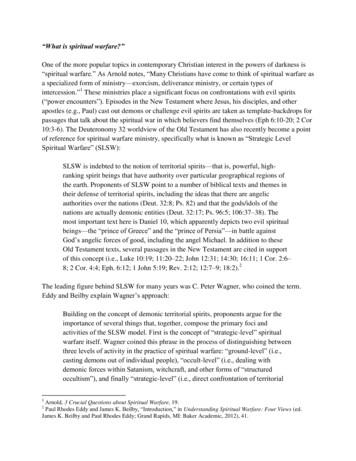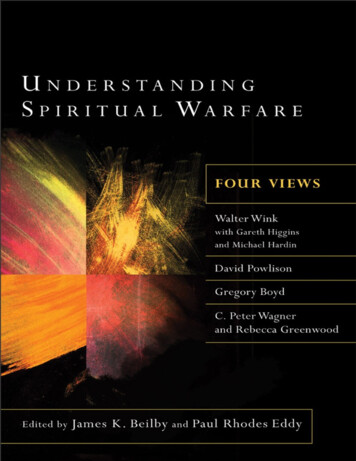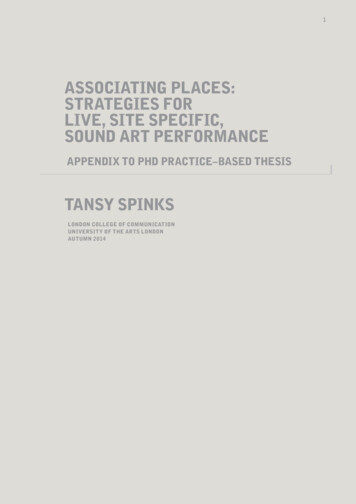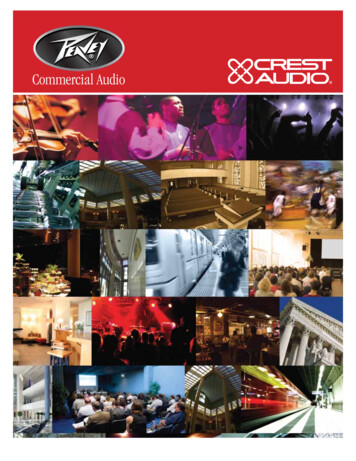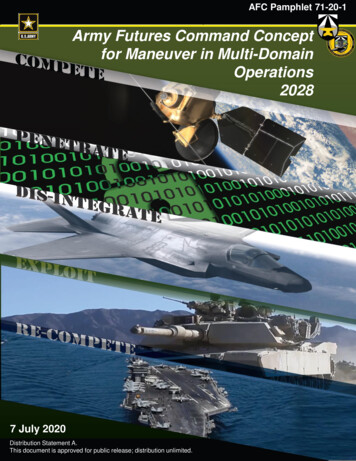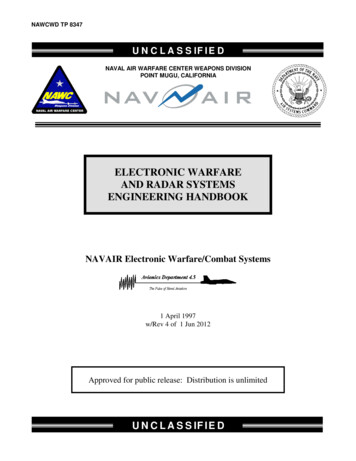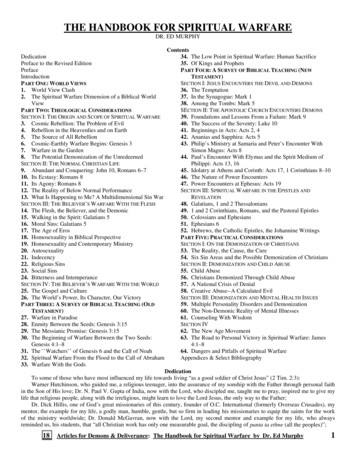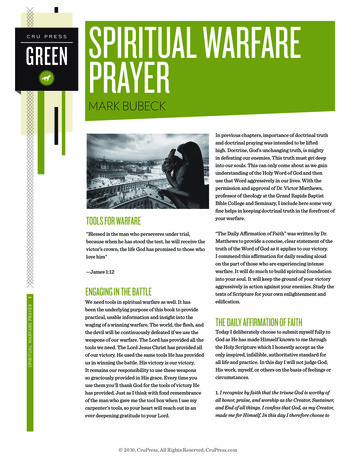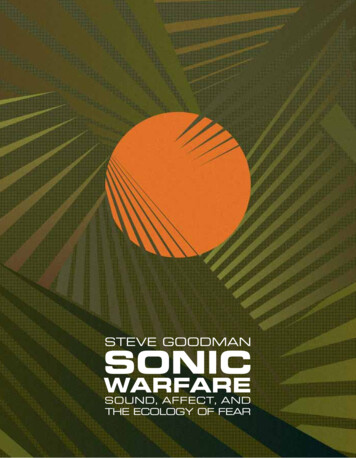
Transcription
SONIC WARFARE
Technologies of Lived AbstractionBrian Massumi and Erin Manning, editorsRelationscapes: Movement, Art, Philosophy, Erin Manning, Without Criteria: Kant, Whitehead, Deleuze, and Aesthetics, Steven Shaviro, Sonic Warfare: Sound, Affect, and the Ecology of Fear, Steve Goodman,
SONIC WARFARESound, Affect, and the Ecology of FearSteve GoodmanThe MIT PressCambridge, MassachusettsLondon, England
Massachusetts Institute of TechnologyAll rights reserved. No part of this book may be reproduced in any form by any electronicor mechanical means (including photocopying, recording, or information storage andretrieval) without permission in writing from the publisher.For information about special quantity discounts, please e-mail special sales@mitpress.mit.eduThis book was set in Syntax and Minion by Graphic Composition, Inc.Printed and bound in the United States of America.Library of Congress Cataloging-in-Publication DataGoodman, Steve.Sonic warfare : sound, affect, and the ecology of fear / Steve Goodman.p. cm. — (Technologies of lived abstraction)Includes bibliographical references and index.ISBN - - - - (hardcover : alk. paper) . Music—Acoustics and physics. . Music—Social aspects. . Music—Philosophy andaesthetics. I. Title.ML .G '. —dc
ContentsSeries 131415161718viiixxiii1998: A Conceptual Event 12001: What Is Sonic Warfare? 52400–1400 B.C.: Project Jericho 151946: Sonic Dominance 271933: Abusing the Military-Entertainment Complex 31403–221 B.C.: The Logistics of Deception 351944: The Ghost Army 411842: Sonic Effects 451977: A Sense of the Future 491913: The Art of War in the Art of Noise 551989: Apocalypse Then 591738: Bad Vibrations 631884: Dark Precursor 691999: Vibrational Anarchitecture 7513.7 Billion B.C.: The Ontology of Vibrational Force 811931: Rhythmanalysis 851900: The Vibrational Nexus 911929: Throbs of Experience 95
viContents192021222324252627282930313233341677: Ecology of Speeds 9999–50 B.C.: Rhythm out of Noise 1051992: The Throbbing Crowd 1091993: Vorticist Rhythmachines 1131946: Virtual Vibrations 1172012: Artificial Acoustic Agencies 1231877: Capitalism and Schizophonia 1291976: Outbreak 1331971: The Earworm 1412025: Déjà Entendu 1491985: Dub Virology 1551928: Contagious Orality 1632020: Planet of Drums 1712003: Contagious Transmission 1772039: Holosonic Control 183Conclusion: Unsound—The (Sub)Politics of 89
Series Foreword“What moves as a body, returns as the movement of thought.”Of subjectivity (in its nascent state)Of the social (in its mutant state)Of the environment (at the point it can be reinvented)“A process set up anywhere reverberates everywhere.”The Technologies of Lived Abstraction book series is dedicated to work of transdisciplinary reach, inquiring critically but especially creatively into processes ofsubjective, social, and ethical-political emergence abroad in the world today.Thought and body, abstract and concrete, local and global, individual and collective: the works presented are not content to rest with the habitual divisions.They explore how these facets come formatively, reverberatively together, if onlyto form the movement by which they come again to differ.Possible paradigms are many: autonomization, relation; emergence, complexity,process; individuation, (auto)poiesis; direct perception, embodied perception,perception-as-action; speculative pragmatism, speculative realism, radical empiricism; mediation, virtualization; ecology of practices, media ecology; technicity; micropolitics, biopolitics, ontopower. Yet there will be a common aim: tocatch new thought and action dawning, at a creative crossing. Technologies of
viiiSeries ForewordLived Abstraction orients to the creativity at this crossing, in virtue of which lifeeverywhere can be considered germinally aesthetic, and the aesthetic anywherealready political.“Concepts must be experienced. They are lived.”Erin Manning and Brian Massumi
AcknowledgmentsA special thanks to Lilian, Bernard, and Michelle for putting up with my noisesince day zero.For the brainpower, thanks to:Jessica Edwards, Torm, Luciana Parisi, Stephen Gordon, Kodwo Eshun, AnnaGreenspan, Nick Land, Mark Fisher, Matt Fuller, Robin Mackay, Kevin Martin, Jeremy Greenspan, Jon Wozencroft, Bill Dolan, Raz Mesinai, Simon Reynolds, Dave Stelfox, Marcus Scott, Mark Pilkington, Erik Davis, Toby Heys, MattFuller, Brian Massumi, Erin Manning, Steven Shaviro, Stamatia Portanova,Eleni Ikoniadou, Cecelia Wee, Olaf Arndt, Joy Roles, James Trafford, JorgeCamachio, Tiziana Terranova, Jeremy Gilbert, Tim Lawrence, Haim Bresheeth,Julian Henriques, Jasmin Jodry, Wil Bevan, Mark Lawrence, Neil Joliffe, SarahLockhart, Martin Clark, Georgina Cook, Melissa Bradshaw, Marcos Boffa, DaveQuintiliani, Paul Jasen, Cyclic Defrost, Derek Walmsley, Jason and Leon at Transition, Doug Sery at MIT.For the ideas, collectivity, and bass, maximum respect to:Ccru, Hyperdub, DMZ, Fwd , Rinse, Brainfeeder.For the sabbatical: The School of Social Sciences, Media and Cultural Studies atUniversity of East London.
pressureNeuralentrainment Organresonanceeffects Nausea Concussionandphysicalimpact Respirationinhibition threshold ofear pain120dB hearing damagedue to prolongedexposure audible tion of audiblefrequenciesCavitation andheating of the bodyat high frequenciesNeural entrainmentTissue damage ifprolonged exposureinaudibleultrasoundunsound nexusof not-yet-audiblefrequenciesunsound soundbecomingtactile0 unsound soundbecomingneuro-affective20kHzfrequency
We’ll come in low out of the rising sun and about a mile out, we’ll put on the music.—General Kilgore, Apocalypse Now
IntroductionIt’s night. You’re asleep, peacefully dreaming. Suddenly the ground begins totremble. Slowly, the shaking escalates until you are thrown off balance, clingingdesperately to any fixture to stay standing. The vibration moves up through yourbody, constricting your internal organs until it hits your chest and throat, makingit impossible to breathe. At exactly the point of suffocation, the floor rips openbeneath you, yawning into a gaping dark abyss. Screaming silently, you stumbleand fall, skydiving into what looks like a bottomless pit. Then, without warning,your descent is curtailed by a hard surface. At the painful moment of impact, as ifin anticipation, you awaken. But there is no relief, because at that precise split second, you experience an intense sound that shocks you to your very core. You lookaround but see no damage. Jumping out of bed, you run outside. Again you see nodamage. What happened? The only thing that is clear is that you won’t be able toget back to sleep because you are still resonating with the encounter.In November , a number of international newspapers reported that the Israeliair force was using sonic booms under the cover of darkness as “sound bombs”in the Gaza Strip. A sonic boom is the high-volume, deep-frequency effect oflow-flying jets traveling faster than the speed of sound. Its victims likened its effect to the wall of air pressure generated by a massive explosion. They reportedbroken windows, ear pain, nosebleeds, anxiety attacks, sleeplessness, hypertension, and being left “shaking inside.” Despite complaints from both Palestinians and Israelis, the government protested that sound bombs were “preferable
xivIntroductionto real ones.” What is the aim of such attacks on civilian populations, and whatnew modes of power do such not-so-new methods exemplify? As with the U.S.Army’s adoption of “shock-and-awe” tactics and anticipative strikes in Iraq, and the screeching of diving bombers during the blitzkriegs of World War II,the objective was to weaken the morale of a civilian population by creating aclimate of fear through a threat that was preferably nonlethal yet possibly asunsettling as an actual attack. Fear induced purely by sound effects, or at leastin the undecidability between an actual or sonic attack, is a virtualized fear. Thethreat becomes autonomous from the need to back it up. And yet the sonicallyinduced fear is no less real. The same dread of an unwanted, possible future isactivated, perhaps all the more powerful for its spectral presence. Despite therhetoric, such deployments do not necessarily attempt to deter enemy action, toward off an undesirable future, but are as likely to prove provocative, to increasethe likelihood of conflict, to precipitate that future.Sonic Warfare: Sound, Affect, and the Ecology of Fear explores the ripplingshockwaves of these kinds of deployments of sound and their impacts on theway populations feel—not just their individualized, subjective, personal emotions, but more their collective moods or affects. Specifically, a concern will beshown for environments, or ecologies, in which sound contributes to an immersive atmosphere or ambience of fear and dread—where sound helps produce a bad vibe. This dimension of an encounter will be referred to as its affectivetone, a term that has an obvious, but rarely explored, affinity to thinking throughthe way in which sound can modulate mood. Yet in the scenario above, the sonicweapon does more than merely produce anxiety. The intense vibration literallythreatens not just the traumatized emotional disposition and physiology of thepopulation, but also the very structure of the built environment. So the termaffect will be taken in this broadest possible sense to mean the potential of anentity or event to affect or be affected by another entity or event. From vibes tovibrations, this is a definition that traverses mind and body, subject and object,the living and the nonliving. One way or another, it is vibration, after all, thatconnects every separate entity in the cosmos, organic or nonorganic.Sonic Warfare outlines the acoustic violence of vibration and the tremblingof temperaments. It sketches a map of forces with each step, constructing concepts to investigate the deployment of sound systems in the modulation of affect.The argument is based on the contention that, to date, most theoretical discussions of the resonances of sound and music cultures with relations of power, intheir amnesia of vibration, have a missing dimension. This missing dimension,
Introductionand the ethico-aesthetic paradigm it beckons, will be termed the politics of frequency. In order to map this black hole, a specifically tuned transdisciplinarymethodology is required that draws from philosophy, science, fiction, aesthetics,and popular culture against the backdrop of a creeping military urbanism. Byconstructing this method as a nonrepresentational ontology of vibrational force,and thus the rhythmic nexus of body, technology, and sonic process, some latentaffective tendencies of contemporary urban cultures in the early-twenty-firstcentury can be made manifest. A (dis)continuum of vibrational force, a vast,disjointed, shivering surface, will be constructed that traverses police and military research into acoustic means of crowd control, the corporate deploymentof sonic branding, through to the intense sonic encounters of strains of soundart and music culture.The book is neither merely an evolutionary or historical analysis of acoustic weaponry, nor primarily a critical-aesthetic statement on the use of sonicwarfare as a metaphor within contemporary music culture. Along the way,various schemes will be indicated, including experiments with infrasonic weapons, the surreal “psycho-acoustic correction” waged by both the U.S. Army inPanama City and the FBI during the Waco siege, and the Maroons whose useof the abeng horn served as a fear inducer in their guerrilla tactics against theBritish colonialists in Jamaica. But this list is not a comprehensive historicalsurvey. Similarly, a total story will not be told, or a critique waged against, themilitarized (and usually macho) posturing that often takes place, from rock tohip-hop, within pockets of both white and black popular music. No doubt interesting things could be said about the amplified walls of sonic intensity andfeedback deployed in rock, from Hendrix, to metal through to bands like SonicYouth and My Bloody Valentine. But this is not a book about white noise—orguitars. Equally, while some attention will be devoted to the key, inventive, sonicprocesses of the African diaspora, a detailed analysis of the innovative politics ofblack noise and militarized stance of Public Enemy and the martial arts mythologies of the Wu Tang clan are sidestepped here, despite the fact that both could fitsnugly into the following pages. Moreover, more conventional representationalor economic problems in the politics of black music will be detoured in favor ofan engagement with the speculative aesthetic politics suggested by Afrofuturism. Ultimately, Sonic Warfare is concerned with the production, transmission,and mutation of affective tonality.Similarly, this book does not aim to be an all-encompassing survey of contemporary developments in military scientific research into sound. En route,xv
xviIntroductionsonic booms over the Gaza Strip, long-range acoustic devices, and musical torture in Iraq and Guantanamo Bay, directional ultrasound in supermarkets andhigh-frequency rat repellents deployed on teenagers will be listened out for. Butthis is not a catalogue of these objectionable deployments.More disclaimers. Given that the themes of the book revolve around potentialsensations of sonic intensity and the moods they provoke, both controlling andcreative, it may strike some readers as strange that the topic of drugs has beenomitted. From ganja to hashish, from cocaine to MDMA, from LSD to ketaminto amphetamine, the nexus of drugs and sonic sensation, the narcosonic, acts asan intensifier of acoustic sensations and serves as both a sensory and informational technology of experimentation, deployed by artists, musicians, producers,dancers, and listeners to magnify, enhance, and mutate the perception of vibration. The narcosonic can also function as a means to economic mobilization,with the lure of these intense experiences used as attractors to consumptionwithin the sprawling network that now constitutes the global clubbing industry.Moreover, like the sonic, the narcotic forms part of the occulted backdrop of themilitary-entertainment complex, in which the modulation of affect becomes aninvisible protocol of control and addiction a means to distract whole populations. Yet again, to do this topic justice in both its affective and geostrategicdimensions merits a more focused project—one that would be sensitive to boththe dangers and empowerments of intoxication.The focus here will always remain slightly oblique to these research themes.While drawing from such primarily empirical projects, Sonic Warfare insteadassumes a speculative stance. It starts from the Spinozan-influenced premisethat “we don’t yet know what a sonic body can do.” By adopting a speculativestance, Sonic Warfare does not intend to be predictive, but instead investigatessome real, yet often virtual, trends already active within the extended andblurred field of sonic culture. What follows therefore attempts to invent someconcepts that can stay open to these unpredictable tendencies, to the potentialinvention of new, collective modes of sensation, perception, and movement.By turning up the amplifier on sound’s bad vibes, the evangelism of the recentsonic renaissance within the academy is countered. By zooming into vibration,the boundaries of the auditory are problematized. This is a necessary startingpoint for a vigilant investigation of the creeping colonization of the not yet audible and the infra- and ultrasonic dimensions of unsound. While it will besuggested that the borders and interstices of sonic perception have always beenunder mutation, both within and without the bandwidth of human audibility, a
Introductionstronger claim will be made that the ubiquitous media of contemporary technoaffective ecologies are currently undergoing an intensification that requires ananalysis that connects the sonic to other modes of military urbanism’s “fullspectrum dominance.” Sonic Warfare therefore concentrates on constructingsome initial concepts for a politics of frequency by interrogating the underlyingvibrations, rhythms, and codes that animate this complex and invisible battlefield—a zone in which commercial, military, scientific, artistic, and popular musical interests are increasingly invested. In this way, the book maps the modes inwhich sonic potentials that are still very much up for grabs are captured, probed,engineered, and nurtured.The flow of the book intentionally oscillates between dense theorization, theclarification of positions and differentiation of concepts, on the one hand, anddescriptive, exemplary episodes drawn from fact and fiction, on the other. Ihope this rhythm will not be too disorienting. The intention has been to presenta text that opens onto its outside from several angles. The text is composed ofan array of relatively short sections that can be read in sequence, from start tofinish as linearly connected blocks. Each section is dated, marking the singularity of a vibrational, conceptual, musical, military, social, or technological event.In addition, these sections can as productively be accessed randomly, with eachchunk potentially functioning as an autonomous module. A glossary has beenprovided to aid with this line of attack.To help with navigation, here is a quick tour of the book’s thematic drift. Themain argument of the book is found in the tension between two critical tendencies tagged the politics of noise and the politics of silence insofar as they constitutethe typical limits to a politicized discussion of the sonic. Admittedly oversimplifying a multitude of divergent positions, both of these tendencies locate thepotential of sonic culture, its virtual future, in the physiologically or culturallyinaudible. Again being somewhat crude, at either extreme, they often cash outpragmatically, on the one hand, in the moralized, reactionary policing of thepolluted soundscape or, on the other, its supposed enhancement by all mannerof cacophony. Sonic Warfare refuses both of these options, of acoustic ecologyand a crude futurism, as arbitrary fetishizations and instead reconstructs thefield along different lines.The book opens with a discussion of the origins, parameters, and contextof the concept of sonic warfare. It will be defined to encompass the physicalityof vibrational force, the modulation of affective tonality, and its use in techniques of dissimulation such as camouflage and deception. The key theoristsxvii
xviiiIntroductionof media technology and war, Friedrich Kittler, Paul Virilio, and, in relation tosonic media, Jacques Attali, will be outlined and extended, forcing them towarda more direct, affective confrontation with the problematics of the militaryentertainment complex. A discontinuum of sonic force will be constructed, connecting examples ofthe modulation of affective tonality within popular and avant-garde music, cinematic sound design, and military and police deployments of acoustic tactics.Futurism responded to this discontinuum through its art of war in the art ofnoise. This artistic response has been revised, mutated, and updated by Afrofuturism, signaling how at the beginning of the twenty-first century, “futurist”approaches must adapt to the mutated temporality of contemporary modes ofcontrol, often referred to as preemptive power or science fiction capital. In recent theories of sonic experience, an attempt is made to bridge the duality of concepts of the “soundscape” and “sound object” from acoustic ecologyand the phenomenology of sound, respectively, through a conception of the“sonic effect.” It will, however, be argued that this does not go far enough: thephenomenology of sonic effects will be transformed into the less anthropocentric environmentality or ecology of vibrational affects. This impetus is continuedinto questions of affective tonality in the sonic dimension of the ecology of fear.How do sonically provoked, physiological, and autonomic reactions of the bodyto fear in the fight, flight, and startle responses scale up into collective, mediaticmood networks? The anticipation of threat will be approached through the dynamics of sonic anticipation and surprise as models of the activity of the futurein the present, and therefore a portal into the operative logic of fear within theemergent paradigm of preemptive power.Drawing from philosophies of vibration and rhythm, Sonic Warfare then detours beneath sonic perception to construct an ontology of vibrational force as abasis for approaching the not yet audible. Here vibration is understood as microrhythmic oscillation. The conceptual equipment for this discussion is found inrhythmanalysis, an undercurrent of twentieth-century thought stretching fromBrazilian philosopher Pinheiros dos Santos, via Gaston Bachelard to Henri Lefebvre. An examination of rhythmanalysis reveals conceptual tensions with influential philosophies of duration such as that of Henri Bergson. The “speculativematerialism” developed by Alfred North Whitehead, it will be argued, offers aroute through the deadlock between Bachelard’s emphasis on the instant andBergsonian continuity, making possible a philosophy of vibrational force basedaround Whitehead’s concept of a nexus of experience—his aesthetic ontology
Introductionand the importance of his notion of “throbs of experience.” These vibrations,and the emergence of rhythm out of noise, will be tracked from molecular tosocial populations via Elias Canetti’s notion of the “throbbing crowd.” This philosophical analysis of vibrational force will be contrasted to Gilles Deleuze andFélix Guattari’s theory of the refrain, and the rhythmic analyses implicit in physical theories of turbulence. The front line of sonic warfare takes place in thesensations and resonances of the texture of vibration. An ontology of vibrationalforce must therefore be able to account for the plexus of analog and digitallymodulated vibration, of matter and information, without the arbitrary fetishization of either. The relation between continuous analog waves and discrete digitalgrains is reformulated in the light of the above. Sonic warfare therefore becomesa sensual mathematics, equally an ecology of code and of vibration.On this philosophical foundation, the affectively contagious radiation ofsonic events through the networks of cybernetic capitalism will then be examined. This audio virology maps the propagational vectors of vibrational events.This involves a critical discussion of the dominant approach to cultural viruses,memetics, and the relation between sonic matter and memory. Sonic strategiesof mood modulation are followed from the military-industrial origins of Muzak, the emergence of musical advertising through jingles into contemporarycorporate sonic branding strategy, and the psychology of earworms and cognitive itches. The aim is to extend the ontology of vibrational force into the tacticaland mnemonic context of viral capitalism. Some speculations will made regarding the acoustic design of ubiquitous, responsive, predatory, branding environments using digitally modeled, contagious, and mutating sonic phenomena inthe programming of autonomous ambiences of consumption. This forces thedomains of sound art, generative music, and the sonic aesthetics of artificial lifeinto the context of a politics of frequency.Whereas predatory branding captures and redeploys virosonic tactics to induce generic consumption, the tactical elaboration of sonic warfare in the fictions of some strains of Black Atlantic sonic futurism take the concept of the“audio virus” beyond the limitations of memetics and digital sound theory.Here, audioviruses are deployed in affective mobilization via the diasporic proliferation of sonic processes, swept along by the carrier waves of rhythm andbass science and a machinic orality. Illustrating the dissemination and abuseof military technologies into popular culture, and developing the concept ofthe audio virus through a discussion of the voice, the military origins of thevocoder will be tracked from a speech encryption device during World War II toxix
xxIntroductionthe spread of the vocodered voice into popular music. This contagious nexus ofbass, rhythm, and vocal science, and their tactics of affective mobilization, willthen be followed into the do-it-yourself pragmatics of sound system cultureswithin the developing sprawls of what Mike Davis has recently referred to as the“Planet of Slums.” What vibrations are emitted when slum, ghetto, shantytown,favela, project, and housing estate rub up against hypercapital? And what kindof harbinger of urban affect do such cultures constitute within contemporaryglobal capitalism?The book concludes by bringing together some speculations on the not yetheard, or unsound, in the twenty-first century, mapping some immanent tendencies of the sonic body within the military-entertainment complex. Theconcept of unsound relates to both the peripheries of auditory perception andthe unactualized nexus of rhythms and frequencies within audible bandwidths.Some suggestions will be made for the further conceptualization of sonic warfare within contemporary societies of control defined by the normalization ofmilitary urbanism and the policing of affective tonality. It is contended that,existing understandings of audiosocial power in the politics of silence and thepolitics of noise must be supplemented by a politics of frequency. The prefix“sub” will be appended to this idea of a politics of frequency. The ambivalenceof the term “(sub)politics of frequency” is deliberate. To some, this will not berecognized as a politics in any conventional sense, but rather lies underneath atthe mutable level of the collective tactics of affective mobilization—so a micropolitics perhaps. While this micropolitics implies a critique of the militarizationof perception, such entanglements, for better or worse, are always productive,opening new ways of hearing, if only to then shut them down again. But moreconcern will be shown for those proactive tactics that grasp sonic processes andtechnologies of power and steer them elsewhere, exploiting unintended consequences of investments in control. For instance, the bracketed prefix “(sub)” isapposite, as a particular concern will be shown for cultures and practices whosesonic processes seek to intensify low-frequency vibration as a technique of affective mobilization. The production of vibrational environments that facilitate thetransduction of the tensions of urban existence, transforming deeply engrainedambiences of fear or dread into other collective dispositions, serve as a model ofcollectivity that revolves around affective tonality, and precedes ideology.
1998: A Conceptual EventSome of these sonic worlds will secede from the mainstream worlds and some will beantagonistic towards it.—Black Audio Film Collective, The Last Angel of History (1997)In an unconscious yet catalytic conceptual episode, the phrase sonic warfare firstwormed its way into memory sometime in the late 1990s. The implantation hadtaken place during a video screening of the The Last Angel of History, producedby British artists, the Black Audio Film Collective. The video charted the coevolution of Afrofuturism:1 the interface between the literature of black science fiction, from Samuel Delaney, Octavia Butler, and Ishmael Reed to Greg Tate andthe history of Afro- diasporic electronic music, running from Sun Ra in jazz, Lee“Scratch” Perry in dub, and George Clinton in funk, right through to pioneersof Detroit techno (Juan Atkins, Derrick May, Carl Craig) and, from the U.K.,jungle and drum’n’bass (A Guy Called Gerald, Goldie). Half way in, the voice ofcultural critic and concept engineer Kodwo Eshun refers to the propaganda ofDetroit techno’s version of Public Enemy, self- proclaimed vinyl guerrillas Underground Resistance. Eshun briefly summarized their audio assault as a kindof cultural hacking against the “mediocre audiovisual” output of the “programmers.” The meme of sonic warfare was repeated only once more in Last Angel.In this cultural war, in which the colonized of the empire strike back throughrhythm and sound, Afrofuturist sonic process is deployed into the networked,diasporic force field that Paul Gilroy termed the Black Atlantic.2 On this cultural1
2Chapter 1MIT Press netlibrary editionnetwork, the result of Euro- American colonialism, practices of slavery andforced migration from Africa, the triangle that connects Jamaica to the UnitedStates to the U.K., has proved a crucially powerful force for innovation in thehistory of Western popular music. The nexus of black musical expression, historical oppression, and urban dystopia has a complex history that has directlygiven rise to and influenced countless sonic inventions, from blues to jazz, fromrhythm and blues to rock ’n’ roll and from soul to funk and reggae. When thismusical war becomes electronic, undergoing a cybernetic phase shift, Westernpopulations become affectively mobilized through wave after wave of machinicdance musics, from dub to disco, from house to techno, from hip- hop to jungle,from dance hall to garage, to grime and forward. Armed with the contagiouspolyrhythmic matrix of the futurhythmachine, this sensual mathematics becomes a sonic weapon in a postcolonial war with Eurocentric culture over thevibrational body and its power to affect and be affected. So if the futurhythmachine constituted a counterculture, it was not just in the sense of a resistanceto white power, but rather in the specu
Series Foreword vii Acknowledgments ix Introduction xiii 1 1998: A Conceptual Event 1 2 2001: What Is Sonic Warfare? 5 3 2400–1400 B.C.:Project Jericho 15 4 1946: Sonic Dominance 27 5 1933: Abusing the Military- Entertainment Complex 31 6 403–221 B.C.:The Logistics of Deception 35 7 1944: The Ghost Army 41 8 1842: S

